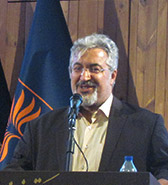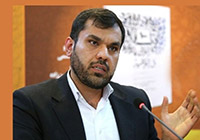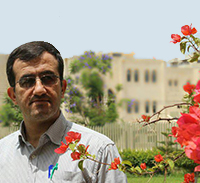The accomplished way and the path ahead from the viewpoints of Gholamreza Azizi, Ali Tatari and Hamid Ghazvini
Issue 400 of weekly magazine released
Maryam Assadi Jafari
Translated By M. B. Khoshnevisan
2019-6-18
Iranian Oral History website – Media activities in the fields of professional subjects such as history and oral history and the continuity in this way need the continuous efforts of the authorities. On the other hand, paying attention to the viewpoints and criticism of serious and diligent audiences is a way to update and preserve the novelty and attractiveness of the content. On the occasion of the release of the issue 400 of the electronic Oral History Weekly, we have asked the viewpoints of three experts and audiences of the weekly magazine.
There are many sacred defense oral history audiences
In his qualitative and quantitative evaluation of Oral History Weekly, Dr. Gholamreza Azizi, the Head of Research Center of the National Library and Archives of Islamic Republic of Iran said, “The endurance of a magazine till issue 400 indicates the efforts of the people who have created (1) and promoted and backed it continuously; since the time of Mr. Mohsen Kazemi (2) so far. I check out the topics and note the necessary materials on the same day the new issue of the weekly is released. On this basis, I believe that the release of the weekly continues with development, progress and being updated.

Since I am involved in “Oral History Biweekly”, I understand the problems related to this job. The control of a four-language weekly shows the high effort of the authorities. The weekly pages have also no problem quantitatively. Heavy material and images are not used in this weekly. Thus, the content is available with any kind of internet and communicational tools. The pages’ designing is very simple which in my view is considered an advantage. The Oral History Weekly during this period has almost reached maturity. But, a series of translated works in the field of the theoretical principles of oral history had been published in a series of articles previously which we miss them now. The translation of Lynn Abrams’ Oral History Theory and the translation of Ali Fat’hali Ashtiani were among the same topics. I suggest translating the works such as “Past Meets Present”. Even smaller articles can also be translated and in this way, the weekly’s newsletter section is highlighted.”
In response to this viewpoint that some of the audiences criticize the concentration of the Oral History website on the issue of the sacred defense, he stressed, “Oral history of Iran was born with the Islamic revolution and became mature with the sacred defense. We have to pay attention to the eight-year war since millions of people were involved in it directly and indirectly and is considered among the greatest events of the century. On the other hand, most books released in the area of oral history revolve around the scared defense. Even most conferences and oral history workshops are also related to the sacred defense. The category of the oral history of the war has several trustees. Moreover, the oral history of the sacred defense has been so closely associated with the lives of people that they have started oral history projects of the war spontaneously and most of these people have been among the combatants of the eight-year sacred defense. The audiences in the area of oral history of the Islamic revolution have been lessened and the elites look for it more and since the number of the audiences of the sacred defense oral history is high, they are moving the weight toward themselves. We have to complain the universities and higher education institutes that why they have not been involved in the issue of oral history yet! We do not have an oral history orientation at the master's degree in history. It is our expectation that the oral history will be outlined in the academic atmosphere and its principles and rules extracted. Oral history activists expect to be supported by universities. It is true that we have dissertations with a focus on oral history at the MA and doctorate degrees, but this does not mean "becoming academic"; these dissertations are the result of the individual efforts of the professors and students. "
At the end, Azizi added, "I in turn sincerely thank the directors of this ponderous weekly."
Criticizing oral history centers
Dr. Ali Tatari, the Head of the Documents Center of the Library of Iranian Majlis (parliament) also congratulated the release of the issue 400 of the electronic weekly of Oral History, and said, "I have received the magazine from the very beginning and it is a great honor that the issue 400 of the weekly has been published. Any journal –whether paper or electronic – afflicts ups and downs. There are fewer publications in the world that keep their audience in the long run or trust them forever. There are many reasons for this claim. Some political, social, and economic challenges affect the quantity and quality of the activities of the journals. Therefore, we should not expect a journal such as oral history to be published with the same quality. We in the area of oral history deal with political discussions too. Political spectrums may be accepted or neglected. The electronic Oral History Weekly Magazine, however takes the average score".

Referring to the history of publishing the applied contents in this weekly magazine, he considered as necessary the updating as well as the innovation and creativity in recognizing the audiences' demands for better presentation of the work's result, and said, "Introducing the charters of oral history is one of your tasks. Also, in recent years, we had several important oral history projects. There were also several active centers in this area that you can reflect their news. However, you have observed the news related to oral history monthly, but in the issue of innovations and creation of attractiveness, I suggest you to examine the status of oral history in Britain, Australia, Germany, France and Eastern Europe countries. For instance, the country of Qatar in the past two years has started an extensive activity in the areas of archive, documents and oral history. Their current priority, however is on the documents, and oral history in their next priorities. You can employ advisors from Europe. They have made predictions for the next hundred years. On the other hand, I feel that there are few good books in the area of oral history. You must write more outspokenly in criticizing the oral history centers. In this way, the attractiveness of the contents would increase.
My other offer is that the website of Iranian Oral History can be involved in executive and operational phase. I mean, it can go out of the form of a media which published news and interviews merely and hold multilateral meetings or expert round tables. For example, a book is selected with the confirmation of some members of the Iranian Oral History Association or the veterans of this area and is criticized as the reference book. In this way, you enter the atmosphere of criticism easier, because you can reflect all of the viewpoints of the participants in the meeting directly. You can publish the result of such meetings in printing form since the Art Center has high potential in terms of place, human resources and management of oral history. Even, you can have one or two issues of magazines annually and publish a selection of the best scientific materials in the area of oral history which has no incompatibility with the electronic form of the magazine.”
These questions and tens of other ones
Hamid Ghazvini, a journalist, history researcher and an author wrote for the Iranian Oral History Weekly Magazine and website, “First of all, I congratulate this promising event namely the release of the issue 400 of the Oral History Weekly Magazine to the founders, managers and writers of the journal in the days when the whole media are facing with financial, professional and content problems.
If the number forty in the Iranian culture and literature is a sign of passing from the period of youth, excitement and inexperience, without any doubt, achieving to ten times of that, is the manifestation of development, maturity and stability.

Without a doubt, the prolonged and regular publication of each journal, with steady and transitory audiences, will lead to attract their trust and to maintain and increase the number of readers and to strengthen the value and credibility of the publication, which is a blessed and auspicious event.
Secondly, regardless of the great job that has been carried out in continuation of the life of this news, analytical and educational journal with a certain professional range and area which is admirable in its own kind, I should remind that the journals (whether paper and digital) have an interactive nature and form and should execute and design their activities in interaction with the audiences. There is a famous phrase which says, “The fate of journals is not determined by the creators but by readers.” For proving this claim, we can take a brief look at the situation of many media in the country today which are facing with the crisis of the audience and inability in attracting and preserving them and probable shutdown.
Naturally, the Oral History Weekly Magazine in its 400th issue, needs to have a clear understanding of the audience and their numerous and diverse needs and attitudes in order to evaluate the way forward and to plan for the coming days in order to form a constructive and useful interaction with them. In this regard, the posing of some questions and paying attention to them by the publishers of the magazine can be useful:
- To what extent has the magazine recognized the needs of the audience and is loyal to them?
- Is there a plan for needs assessment of the audience?
- What is the mechanism for assessing the satisfaction of the audience?
- To what extent has the journal updated itself technically and professionally?
- Has the journal’s content had a growing process since its establishment till today?
- Has the writers’ academic and professional ability been promoted and is there any mechanism for their development?
- To what extent do the articles and reports have innovation and creativity?
- Is there any logical proportion between the field developments in the professional area of the journal and its materials?
- How is the diversity of the materials with the aim of preserving the journal’s attraction?
- Is there any proportion between theoretical and practical content?
It is obvious that answering these questions and tens of other questions of this kind is not just for public dissemination but it’s a professional necessity and compatible with bio-interaction for the people involved with the journal which will make the way forward more clear and passing from it easier".
- Mortza Sarhangi, the founder of the Office of Resistance Literature and Art, the Manager in Charge of Iranian Oral History website and the Manager in Charge of Oral History Weekly Magazine since the first issue
- Mohsen Kazemi, history researcher and writer has been the first Editor-In-Chief of the electronic weekly of Oral History (till issue 13). After him, Mohammad Karimi (till issue 237) was took the responsibility and at present, it is run by under the Editorial Board of the office
Number of Visits: 5671








The latest
Memoirs of Hujjat al-Islam Reza Motalebi
Hujjat al-Islam Reza Motalebi is a cleric from Isfahan. Before the revolution, he was the imam of the Fallah Mosque – which was later renamed Abuzar Mosque. By his presence and efforts, Abuzar Mosque soon became a base for supporters of the Imam and the revolution. After the victory of the revolution, he played a role in uniting forces and maintaining political vitality in southwest Tehran.The Necessity of Receiving Feedback in Oral History
Whenever we engage in a task, we naturally seek ways to evaluate our performance — to correct shortcomings and enhance strengths. Such refinement is only possible through the feedback we receive from others. Consider, for instance, a basketball player whose shots are consistently accurate; should he begin shooting blindfolded, his success rate would rapidly decline, as he would be deprived of essential feedback from each attempt.Sir Saeed
The book “Sir Saeed” is a documentary [narrative] of the life of martyr Seyyed Mohammad Saeed Jafari, written by Mohammad Mehdi Hemmati and published by Rahiyar Publications. In March 2024, this book was recognized as one of the selected documentary biographies in the 21st edition of the Sacred Defense Book of the Year Award. The following text is a review on the mentioned book.Morteza Tavakoli Narrates Student Activities
I am from Isfahan, born in 1336 (1957). I entered Mashhad University with a bag of fiery feelings and a desire for rights and freedom. Less than three months into the academic year, I was arrested in Azar 1355 (November 1976), or perhaps in 1354 (1975). I was detained for about 35 days. The reason for my arrest was that we gathered like-minded students in the Faculty of Literature on 16th of Azar ...

